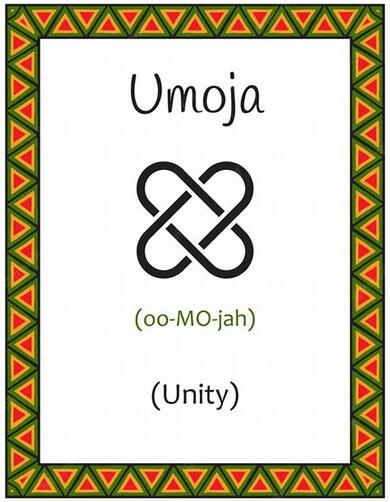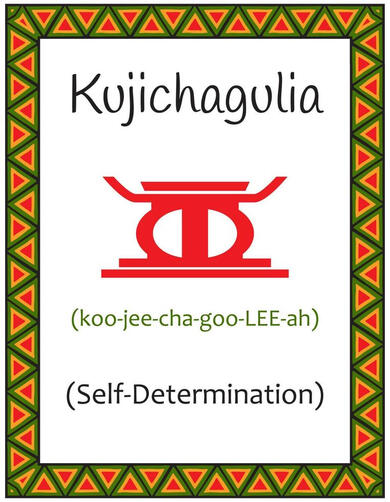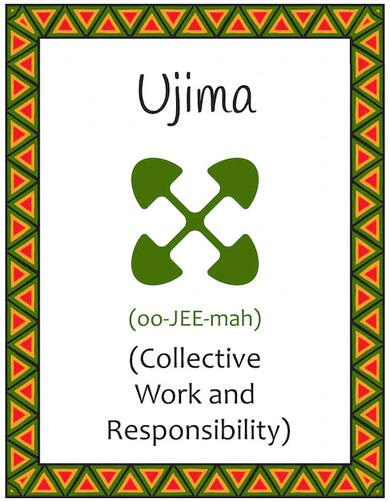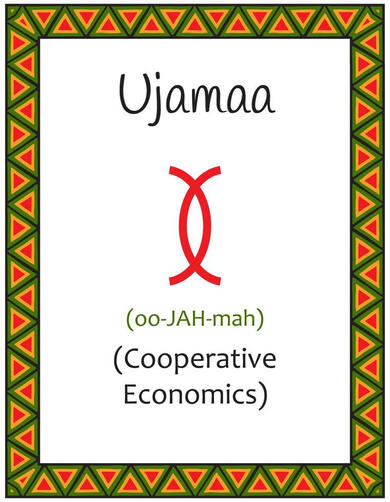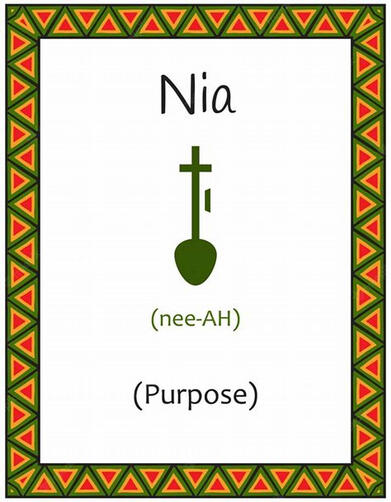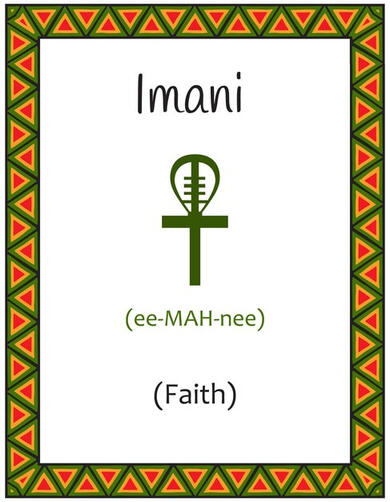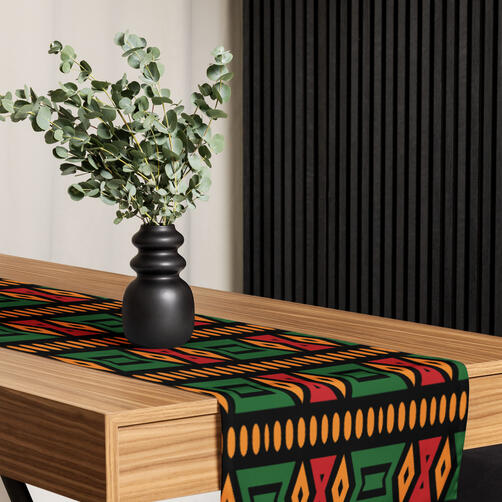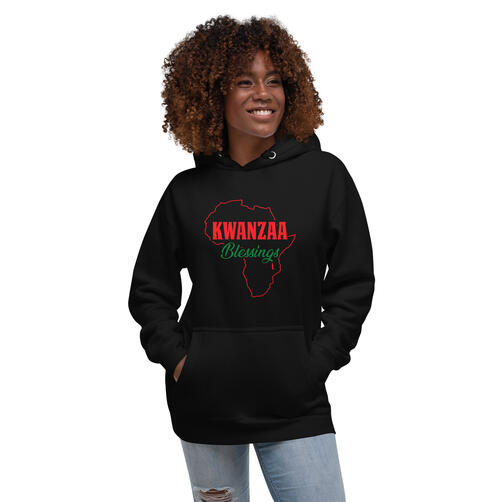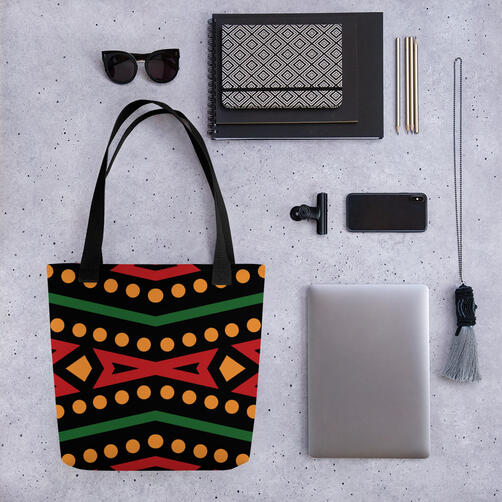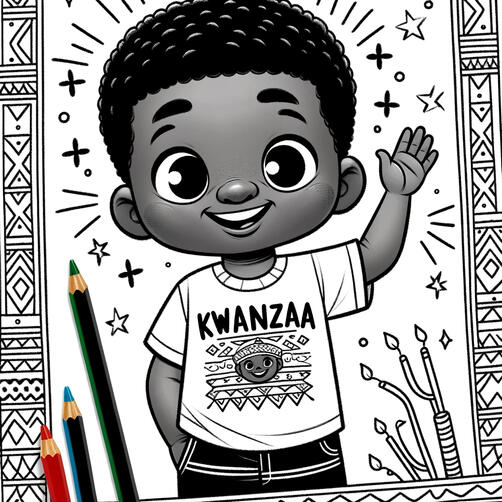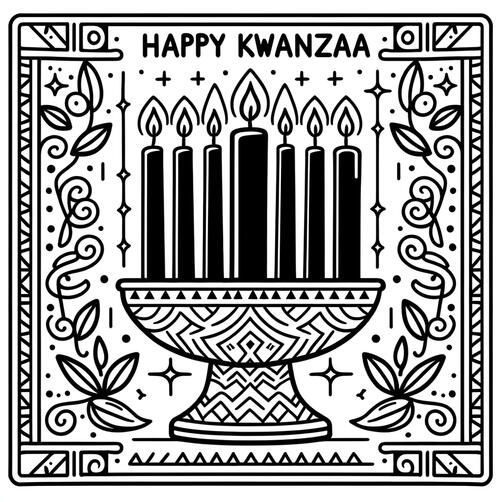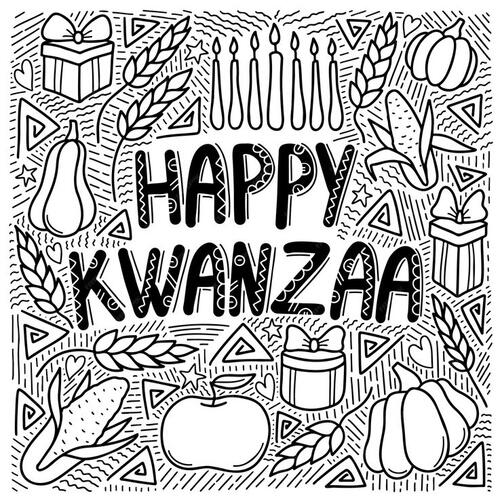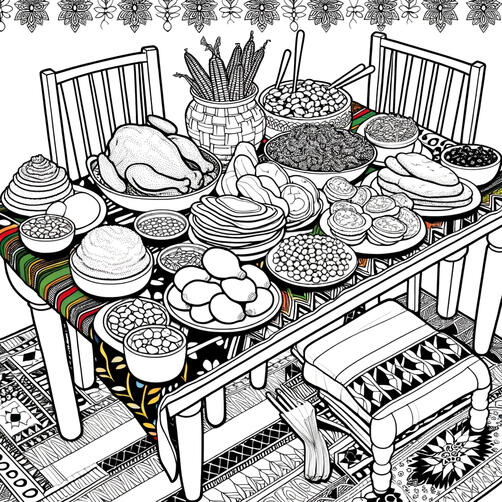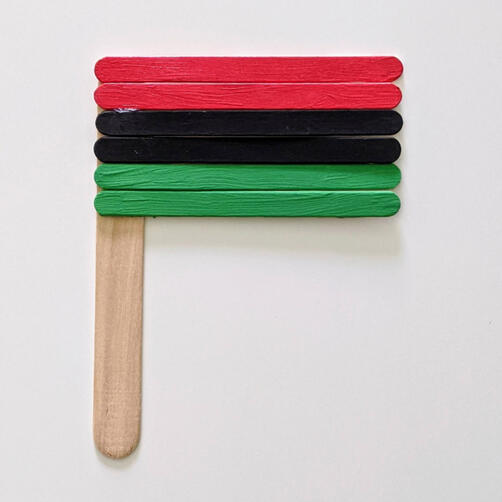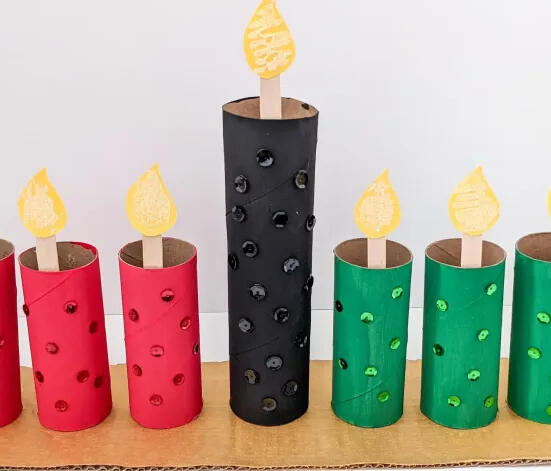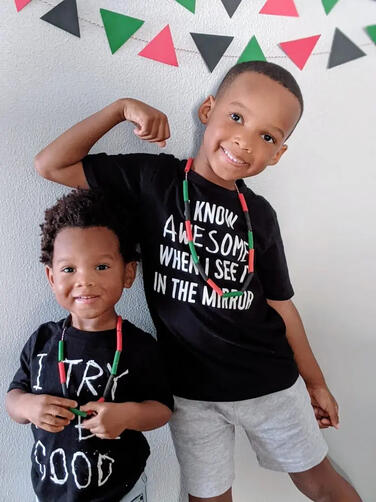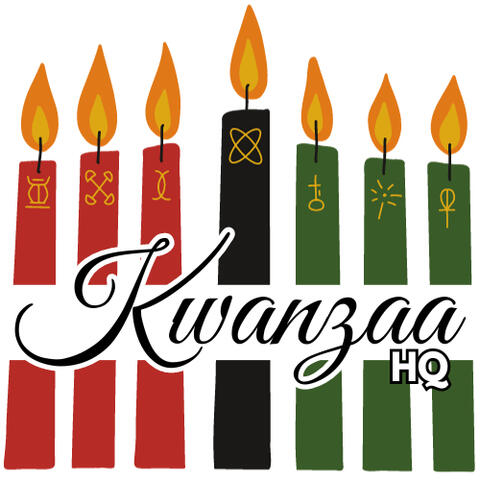
Kwanzaa Headquarters
Welcome to Kwanzaa Headquarters, your Kwanzaa Celebration Hub! Learn how to create a memorable Kwanzaa experience by exploring our comprehensive guide. From lighting the Kinara to engaging in enriching activities, our website provides step-by-step instructions to help you celebrate each day of Kwanzaa.
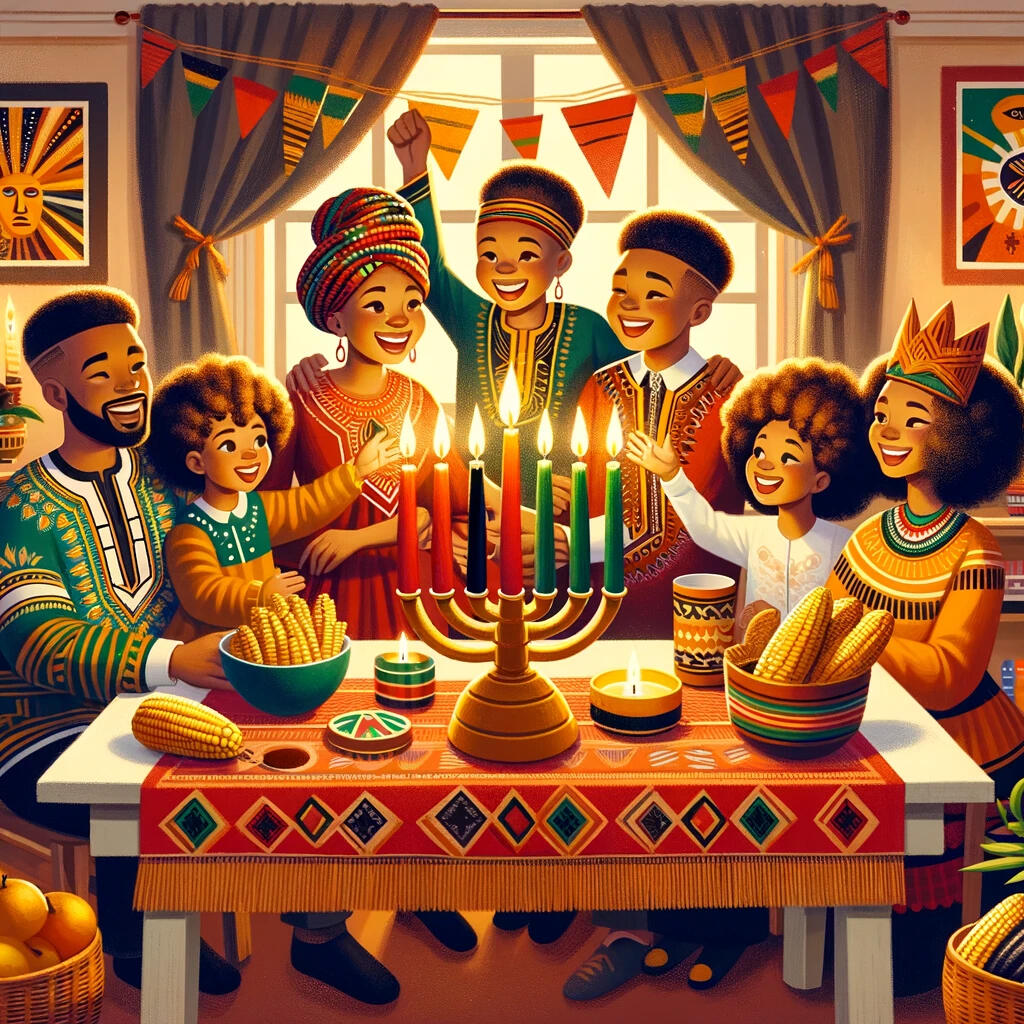
So, you're embarking on the Kwanzaa journey, right? Fantastic choice! Now, I understand that initially, navigating through the principles, candles, and rituals might feel like tackling a maze. However, let me assure you, it's all about practice and dedication. No need for perfection; just go with the flow and enjoy the experience. Kwanzaa is your own unique voyage, and trust me, you'll find your stride.Now, why is Kwanzaa particularly meaningful for the African American community? Picture it as having a distinct seat at the holiday table – a celebration crafted by us, for us. It adds profound meaning to our lives, resonating with our unique experiences. It's a celebration that speaks to the heart, a cultural legacy to pass down. You're becoming part of something truly special.And hey, if you still fancy throwing up a Christmas tree and enjoying those festivities, go ahead! You're in charge of your holiday narrative. Christmas, Kwanzaa, or a delightful blend of both – it's entirely your call. So, absorb the wisdom from the principles, draw encouragement from your unique celebration, and allow the spirit of Kwanzaa to inspire you. Above all, enjoy the moment – it's your celebration, your journey, and your joy. Welcome to the enchantment of Kwanzaa! 🌟
What Is Kwanzaa?
Explore the meaning of Kwanzaa and its seven core principles: Umoja (Unity), Kujichagulia (Self-Determination), Ujima (Collective Work and Responsibility), Ujamaa (Cooperative Economics), Nia (Purpose), Kuumba (Creativity), and Imani (Faith).
Kwanzaa is a week-long celebration that honors African heritage and culture. This special Holiday was created for and is celebrated in the African-American community. It runs from December 26th to January 1st, focusing on seven principles called Nguzo Saba, each representing important values.
Celebrating Kwanzaa
Learn About Kwanzaa and Its Principles:
Familiarize yourself with the seven principles of Kwanzaa, known as Nguzo Saba, and their meanings.
Gather Kwanzaa Symbols and Supplies:
Obtain the essential items for your Kwanzaa celebration, including a Kinara (candleholder), seven candles (3 red, 1 black, 3 green), a Mkeka (mat), Mazao (crops/fruits), a unity cup (Kikombe cha Umoja), and gifts.
Prepare the Space:
Set up a central location where you'll conduct the celebration. Place the Mkeka, Kinara, Mazao, and unity cup in this designated space.
Understand the Candle Lighting Order:
Familiarize yourself with the order of lighting the candles on the Kinara. The black candle represents the African people, the red candles symbolize their struggles, and the green represents hope for the future. The number of candles represents the seven principles of Kwanzaa. Together, the candles are called the mishumaa saba.
Begin Lighting the Candles:
On the first day (December 26), light the black candle (center) and discuss the principle of Umoja (Unity). Each subsequent day, light one additional candle, discussing the relevant principle.
Discuss the Principles:
Each evening we gather with family or friends to discuss the principle associated with the lit candle, sharing thoughts and ideas on how to embody that principle in your life.
Participate in Activities:
We engage in activities related to the daily principle. For example, for Ujima (Collective Work and Responsibility), plan a community service activity together.
Prepare Special Meals:
Each day we prepare special meals featuring African-inspired or Soul Food dishes. Enjoy these meals together as a family, reflecting on the day's principle.
Exchange Meaningful Gifts:
Exchange gifts, preferably handmade, educational and meaningful, with family and friends on the last day of Kwanzaa (January 1).
Incorporate Music and Dance:
Integrate traditional African music and dance into your celebration to infuse joy and cultural enrichment.
Attend Community Events:
Attend Kwanzaa events organized by local communities or cultural centers to immerse yourself in the broader Kwanzaa experience. A simple Google search will let you know what Kwanzaa events may be available in your city.
Reflect and Plan for the Future:
On the final day, reflect on the insights gained during the week and set personal or group goals inspired by the principles of Kwanzaa.
Close with a Feast and Libation Ceremony:
Conclude the celebration with a feast featuring traditional African or African-American cuisine and a libation ceremony to honor ancestors and express hope for the future.
Celebrating Kwanzaa Involves
Setting Up the Mkeka:
A straw or fabric mat symbolizing the foundation for the community. The Unity Cup and Kinara can be placed here.
Lighting the Kinara:
A seven-branched candleholder representing the seven principles. A new candle is lit each day, moving from left to right.
Discussing Principles:
Families discuss one principle each day, reflecting on its significance and how it can be applied in their lives.
Feasting:
Special meals are prepared, often featuring traditional African or African American dishes. Family and friends gather to enjoy the feast.
Gift-Giving:
Handmade gifts and meaningful tokens are exchanged, especially for children, to emphasize creativity, love, and community.
Music and Dance:
Traditional African music and dance are an integral part of Kwanzaa celebrations, symbolizing unity and joy.
Libation Ceremony:
Pouring of libations to honor ancestors and acknowledge their contributions to the community. Often referred to as "pouring for the homies" we take this time to pour for our ancestors and those that paved the way for us today.
Educational Activities:
Reading books, watching films, or attending presentations about African American culture, history, and heritage. With special emphasis on the accomplishments, achievements, and amazingness of African Americans throughout history.
Community Involvement:
Engaging in community service or outreach activities to strengthen bonds and help those in need. You can volunteer at a homeless shelter, help your neighbors, or assist someone you know is in need.
The 7 Days Of Kwanzaa
Day 1 - Umoja (Unity): Emphasizes the importance of unity within the community. Families come together for a communal meal and discuss issues affecting them.
Day 2 - Kujichagulia (Self-Determination): Encourages individuals to define themselves and speak for themselves. Family members discuss personal goals and achievements.
Day 3 - Ujima (Collective Work and Responsibility): Stresses collective responsibility for community development. Families engage in community service or charitable activities.
Day 4 - Ujamaa (Cooperative Economics): Emphasizes building and maintaining African-American-owned businesses. Families may buy from or support African-American businesses during this time.
Day 5 - Nia (Purpose): Encourages setting and fulfilling collective goals for the community. Families discuss their future goals and aspirations.
Day 6 - Kuumba (Creativity): Highlights the need for creativity and ingenuity to improve the community. Families engage in artistic activities, creating crafts or artistic projects.
Day 7 - Imani (Faith): Encourages faith in the community's potential and the promise of a better future. Families discuss their beliefs and hopes for the future.
How To Celebrate
Discover the essence of Kwanzaa and learn how to celebrate this vibrant holiday with authenticity and joy. We invite you to explore the rich traditions, songs, dances, and recipes that make Kwanzaa a special holiday for families and communities. Celebrate the spirit of unity, purpose, and creativity as you embark on your Kwanzaa journey with us.All tasks listed can be done at any time of day, whatever works best for you. This is a brief example of how to celebrate Kwanzaa. A more detailed description of each day, what to do, and how to participate can be found in the links below. Feel free to make adjustments as these are just suggestions. Find your own groove and most of all have fun!
Preparing The Space
Selecting the Space
Choose a suitable indoor or outdoor space that can comfortably accommodate your family or community members. Consider factors like seating, lighting, and decorations.
Clean and Declutter
Ensure the chosen space is clean and organized. Remove any unnecessary clutter to create an inviting and pleasant environment.
Set Up the Kinara (Candle Holder)
Place the Kinara, the candle holder with seven spaces, in the center of the space. Position it on a stable surface like a table or a mat. Place the black candle in the center, three red candles on the left and three green candles on the right of the black candle.
Position the Mkeka (Woven Mat)
Lay the Mkeka, a traditional woven mat, underneath the Kinara to symbolize the foundation of the African heritage and culture.
Arrange the Mishumaa Saba (Seven Candles)
Place the Mishumaa Saba (seven candles) in the Kinara: three red candles on the left, three green candles on the right, and one black candle in the center.
Add Decorations and Symbols
Decorate the surrounding space with African-themed decorations such as African fabric, artwork, traditional items, or artifacts to enhance the cultural ambiance.
Incorporate African Colors
Integrate the colors of the Kwanzaa flag—red, black, and green—in your decorations to represent the struggles, unity, and future of the African diaspora.
Display the Kikombe cha Umoja (Unity Cup)
Place the Kikombe cha Umoja (Unity Cup) on a decorative cloth near the Kinara to symbolize unity and collectivist principles.
Position the Muhindi (Mazao)
Arrange ears of corn (Muhindi) or other crops on the Mkeka, symbolizing the harvest and the rewards of hard work.
Set Up Zawadi (Gifts) Table
Dedicate a table or space for displaying and distributing Zawadi, the gifts that represent the rewards of labor and the commitments made by individuals.
Arrange Seating
Organize seating for family or participants in a circle or semi-circle around the central area where the Kinara and other symbols are placed, promoting unity and togetherness.
Establish a Speaker's Area
Designate a space for the speaker or leader who will guide the ceremony, ensuring they have a clear view of all participants.
Sound and Music
Set up any sound equipment for playing traditional African music, drums, or any other audio that enhances the celebratory atmosphere.
Lighting
Adjust the lighting to create a warm and inviting ambiance, allowing the candles in the Kinara to stand out and illuminate the space.
Final Touches and Personalization
Add any final touches to personalize the space, such as family photos, quotes, or mementos that represent the spirit of unity and purpose.
Test the Setup
Ensure all elements, including the Kinara, candles, decorations, and seating arrangements, are in place and visually appealing.
Welcome and Gather Participants
Welcome participants to the prepared space and gather everyone around for the Kwanzaa ceremony to commence.
Daily Tasks
Day 1 (December 26): Umoja (Unity)
Set up the Kwanzaa display, including the Mkeka, Kinara, Mazao, and unity cup.
Light the black candle (Mishumaa Saba) in the Kinara, representing Umoja (Unity).
Welcome family and/or friends for a gathering that highlights unity and togetherness.
Discuss the principle of Umoja, reflecting on how unity can strengthen the community.
Day 2 (December 27): Kujichagulia (Self-Determination)
Light the black candle and the first red candle in the Kinara, representing Kujichagulia.
Engage in a discussion about personal goals and self-determination.
Encourage each other to define and pursue individual and collective aspirations.
Day 3 (December 28): Ujima (Collective Work and Responsibility)
Light the black candle and two red candles in the Kinara, representing Ujima.
Participate in a collective activity or community service, embodying collective responsibility.
Discuss how working together contributes to community growth and strength.
Day 4 (December 29): Ujamaa (Cooperative Economics)
Light the black candle, two red candles, and the first green candle in the Kinara, representing Ujamaa.
Support African-American businesses by purchasing items or services from them.
Discuss the significance of cooperative economics in building a strong community.
Day 5 (December 30): Nia (Purpose)
Light the black candle, two red candles, and the second green candle in the Kinara, representing Nia.
Discuss and set goals for the upcoming year, focusing on collective purpose and direction.
Encourage each other to pursue meaningful and purposeful endeavors.
Day 6 (December 31): Kuumba (Creativity)
Light the black candle, two red candles, and the third green candle in the Kinara, representing Kuumba.
Engage in creative activities, such as crafting, music, or dance, celebrating the richness of African culture.
Share and showcase your creations, fostering creativity and appreciation.
Day 7 (January 1): Imani (Faith)
Light all the candles in the Kinara, representing Imani.
Reflect on the principles discussed throughout the week and express faith in a brighter future for the community.
Exchange meaningful gifts, emphasizing love, creativity, and unity.
This is the day for your Kwanzaa Feast! Cook/Buy all of your favorite Soul Food dishes and dine with your family.
Marketplace
Step into the vibrant world of Kwanzaa with our Kwanzaa Marketplace. Here you'll find a carefully curated selection of Kwanzaa supplies, decorations, and thoughtful gifts. We offer an array of beautifully crafted Kinara candleholders, dinnerware, and Kwanzaa decorations to set the perfect atmosphere for your celebration.
Children's Corner
Introduce children to the rich traditions of Kwanzaa through our engaging and educational Kwanzaa Crafts for Kids section. We provide a delightful collection of creative and age-appropriate craft ideas that allow young ones to explore the values and symbols of Kwanzaa while having fun. These hands-on activities are perfect for fostering creativity, understanding, and a sense of unity among the youngest members of your family.
Day 1 - Umoja (Unity)
Day 1 is the day of Umoja which means Unity. It is celebrated on December 26. These activities offer various ways to honor the principle of unity (Umoja) on the first day of Kwanzaa, fostering a sense of togetherness, appreciation, and mutual respect.
Candle Lighting
Umoja (Unity) - Black Candle
On the first day of Kwanzaa (December 26), the black center candle, representing Umoja (Unity), is lit.
The leader of the ceremony speaks about the meaning and importance of unity within the family, community, and nation.
Light the black center candle symbolizing the first principle Umoja (Unity).
Provided below are examples of what you can say during your ceremony. Feel free to adjust the script to resonate with your family's beliefs and sentiments, ensuring it reflects the essence of Umoja and the celebration of Unity.
Short Script Example
[Begin with the Kinara unlit. The family gathers around the Kinara.]Leader (Designated family member):
"Today, we light the first candle for Umoja—unity. Together, we are stronger and more caring. Let's stand united as a family and community."[Light the black center candle.]Leader:
"Let this light remind us of our power when we support and uplift one another. Happy Kwanzaa!"[End of the candle lighting ceremony for Day 1. You may now blow out the candle.]
Long Script Example
[Begin with the Kinara unlit. The family gathers around the Kinara.]Leader (Designated family member):
"Good [morning/afternoon/evening], and welcome to our Kwanzaa celebration as we begin this joyous journey of unity and togetherness. Today, we light the first candle, representing the principle of Umoja, which means unity."[Light the black center candle.]Leader:
"As we light this black candle, let us reflect upon the importance of unity within our family and our community. Umoja calls us to come together, to stand as one, to support and uplift each other in love and harmony. Together, we are stronger."[Pause for reflection.]Leader:
"Unity doesn't mean we will always agree, but it means we stand by each other, even in our differences. It means listening, understanding, and valuing one another. It means being a part of a collective force that can bring positive change."[Pause for reflection.]Leader:
"Let us strive to embody the spirit of Umoja, promoting unity not only within our family but within our community and beyond. Together, we can achieve great things. Let this candle be a beacon, reminding us of the strength we have when we stand united."[Pause for reflection.]Leader:
"As we move forward through this week of Kwanzaa, may the light of unity guide our hearts and actions. Ashe!"All (together):
"Ashe!"[End of the candle lighting ceremony for Day 1. You may now blow out the candle.]
Daily Tasks
Family Unity Gathering
Plan a special family gathering where all members come together to celebrate the start of Kwanzaa.
Reflect on family values, traditions, and the importance of unity in overcoming challenges.
Community Potluck Dinner
Organize a community potluck dinner where neighbors and friends can bring dishes from their respective cultural backgrounds.
Encourage conversations about unity and how a diverse community can come together as one.
Unity Art Project
Engage family or community members in a collaborative art project symbolizing unity.
Each participant contributes to the artwork, representing their unique qualities that, when combined, create something beautiful.
Unity Candle Lighting Ceremony
Host a candle lighting ceremony where each family member lights a candle, symbolizing their individuality.
Discuss how, together, these individual lights form a strong, unified glow.
Family Storytelling Session
Gather as a family to share stories of ancestors, emphasizing the unity of generations and the legacy they've passed down.
Encourage open dialogue and active listening to strengthen family bonds.
Unity Puzzle Challenge
Work on a puzzle as a family, highlighting how each piece is unique but necessary to complete the picture.
Discuss how unity brings completeness and success in any endeavor.
Unity Circle and Reflections
Form a circle with family members and reflect on past achievements and shared experiences.
Express gratitude for the support and unity that have brought the family to this point.
Unity Planting Ritual
Plant a tree or a group of plants symbolizing growth, strength, and unity.
Discuss how nurturing and caring for these plants mirrors the unity and care needed within the community.
Unity Music Jam Session
Have a family music session where each member plays an instrument, sings, or participates in some way.
Emphasize how harmony and unity in music can serve as metaphors for harmony and unity in life.
Unity Family Pledge
Draft a family unity pledge, highlighting commitments to support and uphold unity within the family throughout the year.
Read and collectively sign the pledge, reinforcing the family's dedication to unity.
Day 2 - Kujichagulia (Self-Determination)
Day 2 is the day of Kujichagulia which means Unity. It is celebrated on December 27. These activities aim to honor the principle of Kujichagulia (Self-Determination) on the second day of Kwanzaa, promoting self-awareness, empowerment, and the ability to define one's own destiny.
Candle Lighting
Kujichagulia (Self-Determination) - First Red Candle
On the second day of Kwanzaa (December 27), the first red candle, representing Kujichagulia (Self-Determination), is lit.
The leader speaks about the concept of self-determination and its relevance in personal and community growth.
Re-light the black center candle and then the first red candle, to the left, representing Kujichagulia (Self-Determination).
Provided below are examples of what you can say during your ceremony. Feel free to adjust the script to resonate with your family's beliefs and sentiments, ensuring it reflects the essence of Kujichagulia and the celebration of self-determination.
Short Script Example
[Begin with the Kinara. The family gathers around the Kinara.]Leader (Designated family member):
"Today, we light the second candle for Kujichagulia—self-determination. It means deciding our path and making our dreams come true."[Light the black center candle and the first red candle.]Leader:
"May this light remind us to believe in ourselves and work for what we want. Happy Kwanzaa!"[End of the candle lighting ceremony for Day 2. You may now blow out the candles.]
Long Script Example
[Begin with the Kinara. The family gathers around the Kinara.]Leader (Designated family member):
"Good [morning/afternoon/evening], and welcome to our Kwanzaa celebration as we continue our journey of reflection and growth. Today, we light the second candle, representing the principle of Kujichagulia, which means self-determination."[Light the black center candle and the first red candle.]Leader:
"As we light these candles, let us reflect upon the importance of defining ourselves, speaking for ourselves, and determining our own destinies. Kujichagulia urges us to carve our paths and create our identities."[Pause for reflection.]Leader:
"We are each unique individuals with our own dreams, desires, and potential. It is our responsibility to embrace our uniqueness and define our purpose in life. We have the power to make choices and shape our journey."[Pause for reflection.]Leader:
"Let us carry the flame of self-determination within us, empowering ourselves and our loved ones to strive for greatness, to believe in our abilities, and to march confidently towards our aspirations."[Pause for reflection.]Leader:
"May this candle remind us that we possess the strength to define our own narrative and that of our community. Let us honor this principle by encouraging self-expression and supporting one another in our journeys."[Pause for reflection.]Leader:
"As we continue this week of Kwanzaa, may the light of self-determination guide our choices and inspire us to achieve our dreams. Ashe!"All (together):
"Ashe!"[End of the candle lighting ceremony for Day 2. You may now blow out the candles]
Daily Tasks
Personal Vision Board Creation
Encourage family members to create individual vision boards, showcasing their aspirations and goals.
Discuss how self-determination plays a vital role in achieving these objectives.
Family Goal-Setting Session
Hold a family meeting to collectively set short-term and long-term goals for the household.
Emphasize the importance of self-determination in reaching these goals as a family unit.
Empowerment Workshop or Seminar
Organize a workshop or seminar focused on empowerment and self-determination.
Invite a guest speaker to share insights and motivate participants to define their paths.
Strengths and Talents Showcase
Encourage family members to showcase their unique strengths, talents, or hobbies.
Discuss how recognizing and nurturing individual talents contribute to self-determination.
Positive Affirmations Exercise
Engage in a family activity where everyone writes positive affirmations about themselves.
Share these affirmations aloud, reinforcing self-determination and self-confidence.
Journaling and Reflection Time
Provide journals for family members to reflect on their personal journeys, goals, and self-determination.
Set aside time for sharing and discussing these reflections as a family.
Career Planning and Mentorship Session
Organize a session where family members can discuss their career aspirations and seek advice from mentors within the family or community.
Encourage setting clear career goals and strategies for achieving them.
Community Involvement Project
Collaborate on a community project that aligns with the values and aspirations of the family.
Emphasize the power of self-determination in making a positive impact on the community.
Self-Expression Through Art
Provide art supplies and encourage family members to express themselves through artistic creations.
Discuss how art is a form of self-determination and personal expression.
Mindfulness and Meditation Session
Engage in a mindfulness or meditation session as a family, focusing on inner peace and self-awareness.
Reflect on the power of self-determination in achieving mental well-being and balance.
Day 3 - Ujima (Collective Work and Responsibility)
Day 3 is the day of Ujima which means Collective Work and Responsibility. It is celebrated on December 28. These activities aim to honor the principle of Ujima (Collective Work and Responsibility) on the third day of Kwanzaa, fostering a sense of shared responsibility and the understanding that collective effort leads to a stronger community.
Candle Lighting
Ujima (Collective Work and Responsibility) - First Green Candle
On the third day of Kwanzaa (December 28), the second red candle, representing Ujima (Collective Work and Responsibility), is lit.
The leader discusses the importance of working together and taking responsibility for one another in the community.
Re-light the black center candle, the first red candle (left), and then the first green candle, from left to right, representing Ujima (Collective Work and Responsibility) and all principles so far.
Provided below are examples of what you can say during your ceremony. Feel free to modify the script to align with your family's beliefs and values, ensuring it encapsulates the essence of Ujima and the celebration of collective work and responsibility.
Short Script Example
[Begin with the Kinara. The family gathers around the Kinara.]Leader (Designated family member):
"Today, we light the third candle for Ujima—working together. It means when we help each other, we become stronger."[Light the black center candle, the first red candle, and the second red candle.]Leader:
"Let this light remind us to support our community. Together, we can achieve great things. Happy Kwanzaa!"[End of the candle lighting ceremony for Day 3. You may now blow out the candles.]
Long Script Example
[Begin with the Kinara. The family gathers around the Kinara.]Leader (Designated family member):
"Good [morning/afternoon/evening], and welcome to our Kwanzaa celebration as we progress in our journey of unity and purpose. Today, we light the third candle, representing the principle of Ujima, which means collective work and responsibility."[Light the black center candle, the first red candle, and the second red candle.]Leader:
"As we light these candles, let us reflect upon the importance of coming together to work for the common good and take responsibility for our community. Ujima calls us to strengthen our bonds and uplift one another."[Pause for reflection.]Leader:
"Our community's growth and well-being are our shared responsibility. We must actively work together, shoulder each other's burdens, and celebrate our triumphs as a collective."[Pause for reflection.]Leader:
"Let us embrace the spirit of Ujima, recognizing that our actions affect our community's success and prosperity. Each effort, no matter how small, contributes to the larger tapestry of our collective journey."[Pause for reflection.]Leader:
"May this candle remind us of our duty to collaborate, support, and uplift one another. Let us honor this principle by committing ourselves to community service and understanding that together, we are stronger."[Pause for reflection.]Leader:
"As we continue this week of Kwanzaa, may the light of collective work and responsibility guide our actions and inspire us to build a better community. Ashe!"All (together):
"Ashe!"[End of the candle lighting ceremony for Day 3. You may now blow out the candles.]
Daily Tasks
Community Clean-Up or Beautification Project
Organize a family or community clean-up or beautification project to collectively improve a public space.
Discuss the impact of working together for the common good, embodying the spirit of Ujima.
Collaborative Cooking and Meal Sharing
Prepare a communal meal where each family member contributes a dish, showcasing unity in cooking and sharing responsibilities.
Discuss how cooperation in meal preparation reflects the essence of Ujima.
Community Outreach and Support
Volunteer as a family at a local charity, shelter, or food bank to provide assistance to those in need.
Reflect on the significance of collective effort in addressing community challenges.
Family DIY Project
Undertake a do-it-yourself (DIY) home improvement or creative project as a family, pooling skills and resources.
Discuss the importance of collective work in achieving a shared goal.
Group Exercise or Physical Activity
Engage in a group exercise or physical activity session, highlighting the benefits of working together towards fitness goals.
Emphasize how collective effort enhances health and wellness.
Collaborative Learning Session
Host a learning session where family members share knowledge and teach each other about their areas of expertise.
Discuss how collective learning and sharing of skills contribute to the family's growth and knowledge base.
Crafting and Artistry Showcase
Collaborate on a family arts and crafts project, where each member contributes their artistic talents to create a collective masterpiece.
Highlight how collective creativity enhances the project's beauty and diversity.
Community Garden Planting
Participate in planting a community garden, promoting collective responsibility for environmental sustainability and food security.
Discuss the role of each individual in nurturing and caring for the garden.
Collective Fundraising for a Cause
Organize a family or community fundraising event to support a charitable cause or organization.
Discuss how pooling resources for a common cause showcases collective responsibility.
Family Book Club Discussion
Read a book related to collective work and responsibility, then hold a family discussion to exchange insights and ideas.
Reflect on how the themes in the book relate to Ujima and its significance.
Day 4 - Ujamaa (Cooperative Economics)
Day 4 is the day of Ujamaa which means Cooperative Economics. It is celebrated on December 29. These activities aim to honor the principle of Ujamaa (Cooperative Economics) on the fourth day of Kwanzaa, focusing on economic cooperation, supporting local businesses, and fostering financial growth within the community.
Candle Lighting
Ujamaa (Cooperative Economics) - Second Red Candle
On the fourth day of Kwanzaa (December 29), the first green candle, representing Ujamaa (Cooperative Economics), is lit.
The leader talks about the significance of supporting and building economic strength within the community.
Re-light the black center candle, the first red candle (left), the first green candle (right), and then the second red candle (left), alternating from left to right and left again, representing Ujamaa (Cooperative Economics) and all principles so far.
Provided below are examples of what you can say during your ceremony. Feel free to tailor the script to resonate with your family's beliefs and values, ensuring it embodies the essence of Ujamaa and the celebration of cooperative economics.
Short Script Example
[Begin with the Kinara. The family gathers around the Kinara.]Leader (Designated family member):
"Today, we light the fourth candle for Ujamaa—working and supporting together. It means we grow stronger when we help each other."[Light the black center candle, the first red candle, the second red candle, and the first green candle.]Leader:
"Let this light remind us to support our community's businesses and lift each other up. Happy Kwanzaa!"[End of the candle lighting ceremony for Day 4. You may now blow out the candles.]
Long Script Example
[Begin with the Kinara. The family gathers around the Kinara.]Leader (Designated family member):
"Good [morning/afternoon/evening], and welcome to our Kwanzaa celebration as we advance in our journey of unity, purpose, and collective work. Today, we light the fourth candle, representing the principle of Ujamaa, which means cooperative economics."[Light the black center candle, the first red candle, the second red candle, and the first green candle.]Leader:
"As we light these candles, let us reflect upon the importance of cooperative economics in our community. Ujamaa encourages us to build and maintain our businesses together, sharing the fruit of our labor."[Pause for reflection.]Leader:
"Cooperative economics is the cornerstone of community prosperity. When we support local businesses, we invest in the growth and stability of our community, fostering financial strength and self-sufficiency."[Pause for reflection.]Leader:
"Let us embody the spirit of Ujamaa by patronizing and empowering African-American owned businesses. Our collective economic growth is a testament to our unity and shared vision."[Pause for reflection.]Leader:
"May this candle remind us of our power to uplift our community through economic cooperation. Let us honor this principle by practicing mindful spending and supporting local businesses."[Pause for reflection.]Leader:
"As we continue this week of Kwanzaa, may the light of cooperative economics guide our financial decisions and inspire us to build an economically empowered community. Ashe!"All (together):
"Ashe!"[End of the candle lighting ceremony for Day 4. You may now blow out the candles.]
Daily Tasks
Supporting African-American Businesses
Plan a family shopping trip to support local African-American-owned businesses.
Discuss the importance of supporting these businesses and their role in community growth.
Financial Literacy Workshop
Organize a workshop focused on financial literacy and cooperative economics.
Discuss budgeting, saving, investing, and how financial knowledge can strengthen the community.
Community Marketplace Event
Coordinate a community marketplace event where local African-American artisans and entrepreneurs can showcase their products.
Encourage attendees to purchase items and invest in the community's economic growth.
Financial Planning Discussion
Sit down as a family to discuss financial goals and plan for the future.
Emphasize the significance of cooperative economics in achieving family financial aspirations.
Community Investment Seminar
Arrange a seminar where a financial expert speaks about the benefits of community investing and cooperative ventures.
Discuss ways to invest in and support local initiatives.
Cooperative Cooking and Sharing
Collaboratively cook a meal with friends or extended family members, and share the cost and efforts.
Discuss how this sharing model can be applied to other aspects of life.
Youth Entrepreneurship Showcase
Arrange an event where young family members can present their entrepreneurial ideas and projects.
Encourage support and investment in the youth's endeavors.
Small Business Development Workshop
Host a workshop focusing on starting and growing small businesses within the community.
Discuss the importance of community support for sustainable entrepreneurship.
Community Investment Group Formation
Gather interested community members to discuss forming a community investment group.
Brainstorm ideas for collective ventures and investments.
Cooperative Dinner and Discussion
Organize a cooperative dinner with friends or community members, where each attendee brings a dish to share.
Engage in discussions about cooperative economics and the benefits of collaboration.
Day 5 - Nia (Purpose)
Day 5 is the day of Nia which means Purpose. It is celebrated on December 30. These activities aim to honor the principle of Nia (Purpose) on the fifth day of Kwanzaa, fostering a deeper understanding of personal and collective purpose, and encouraging actions that align with meaningful goals and values.
Candle Lighting
Nia (Purpose) - Second Green Candle
On the fifth day of Kwanzaa (December 30), the second green candle, representing Nia (Purpose), is lit.
The leader discusses finding purpose and setting goals for the benefit of the community.
Re-light the black center candle, the first red candle (left), the first green candle (right), the second red candle (left), and then the second green candle (right), alternating from left to right back and forth, representing Nia (Purpose) and all principles so far.
Provided below are examples of what you can say during your ceremony. Feel free to adjust the script to resonate with your family's beliefs and values, ensuring it embodies the essence of Nia and the celebration of purpose.
Short Script Example
[Begin with the Kinara. The family gathers around the Kinara.]Leader (Designated family member):
"Today, we light the sixth candle for Kuumba—creativity. It means using our imaginations and making our world beautiful."[Light the black center candle, the first red candle, the second red candle, the first green candle, the second green candle, and the third green candle.]Leader:
"Let this light remind us to embrace our creativity and make our community vibrant. Happy Kwanzaa!"[End of the candle lighting ceremony for Day 6. You may now blow out the candles.]
Long Script Example
[Begin with the Kinara. The family gathers around the Kinara.]Leader (Designated family member):
"Good [morning/afternoon/evening], and welcome to our Kwanzaa celebration as we continue our journey of unity, purpose, cooperative economics, collective work, and embracing our unique purpose. Today, we light the sixth candle, representing the principle of Kuumba, which means creativity."[Light the black center candle, the first red candle, the second red candle, the first green candle, the second green candle, and the third green candle.]Leader:
"As we light these candles, let us reflect upon the importance of creativity in our lives and community. Kuumba encourages us to use our creativity to leave our community more beautiful and beneficial than we inherited it."[Pause for reflection.]Leader:
"Our creativity is a powerful force for positive change. It's the essence of our culture, expressed through art, music, dance, and innovation. It reflects our vibrant identity."[Pause for reflection.]Leader:
"Let us embody the spirit of Kuumba by embracing and celebrating our creative abilities. Each one of us has a unique gift to offer, and by sharing our creativity, we enrich our community."[Pause for reflection.]Leader:
"May this candle remind us of the beauty and richness that creativity brings to our lives and community. Let us honor this principle by encouraging and supporting one another's artistic expression."[Pause for reflection.]Leader:
"As we continue this week of Kwanzaa, may the light of creativity guide our hearts and inspire us to create a more vibrant and harmonious community. Ashe!"All (together):
"Ashe!"[End of the candle lighting ceremony for Day 6. You may now blow out the candles.]
Daily Tasks
Family Purpose Statement Creation
Gather as a family to create a purpose statement, reflecting shared values and goals.
Discuss individual roles in achieving the family's purpose and the impact on the community.
Community Vision Board Workshop
Organize a workshop where community members can create vision boards showcasing their collective aspirations.
Discuss how aligning individual purposes contributes to a stronger, purpose-driven community.
Individual Purpose Reflection
Encourage family members to spend time reflecting on their personal purpose and life goals.
Share insights and discuss how understanding one's purpose can lead to a fulfilling life.
Charity Fundraising Event
Host a charity fundraising event where the proceeds go towards a cause that aligns with the family or community's purpose.
Discuss the impact of collective giving and its relation to purposeful action.
Family Purposeful Act Day
Dedicate a day to performing purposeful acts as a family, such as volunteering, supporting a cause, or helping neighbors.
Reflect on the positive impact and how each act contributes to fulfilling a greater purpose.
Educational Forum on Purpose
Arrange a forum with guest speakers discussing the concept of purpose and its importance in personal and community development.
Encourage questions and an open dialogue on finding purpose.
Individual Purpose Presentations
Ask family members to prepare short presentations about their personal purposes and goals.
Discuss commonalities and ways the family can support each other in achieving their purposes.
Mindfulness and Purpose Meditation
Engage in a mindfulness and purpose meditation session as a family, focusing on intentions and alignment with personal purpose.
Share experiences and insights gained during the meditation.
Career Mentorship and Guidance
Arrange for family members to offer mentorship or guidance to younger family members in exploring potential careers and purposes.
Encourage meaningful conversations about career choices and aligning them with one's purpose.
Cultural Heritage Exploration
Explore and learn about the cultural heritage and history of the family or community, highlighting the purpose that binds generations together.
Reflect on how preserving and understanding heritage serves a greater purpose.
Day 6 - Kuumba (Creativity)
Day 6 is the day of Kuumba which means Creativity. It is celebrated on December 31. These activities aim to honor the principle of Kuumba (Creativity) on the sixth day of Kwanzaa, promoting and celebrating creative expression in various forms and emphasizing its importance in preserving culture and fostering unity.
Candle Lighting
Kuumba (Creativity) - Third Red Candle
On the sixth day of Kwanzaa (December 31), the first red candle is lit again, representing Kuumba (Creativity).
The leader emphasizes the importance of creativity and innovation in enhancing the community.
Re-light the black center candle, the first red candle (left), the first green candle (right), the second red candle (left), the second green candle (right), and then the third red candle (left), representing Kuumba (Creativity) and all other principles so far.
Provided below are examples of what you can say during your ceremony. Feel free to tailor the script to resonate with your family's beliefs and values, ensuring it embodies the essence of Kuumba and the celebration of creativity.
Short Script Example
[Begin with the Kinara. The family gathers around the Kinara.]Leader (Designated family member):
"Today, we light the sixth candle for Kuumba—creativity. It means using our imaginations and making our world beautiful."[Light the black center candle, the first red candle, the second red candle, the first green candle, the second green candle, and the third green candle.]Leader:
"Let this light remind us to embrace our creativity and make our community vibrant. Happy Kwanzaa!"[End of the candle lighting ceremony for Day 6. You may now blow out the candles.]
Long Script Example
[Begin with the Kinara. The family gathers around the Kinara.]Leader (Designated family member):
"Good [morning/afternoon/evening], and welcome to our Kwanzaa celebration as we continue our journey of unity, purpose, cooperative economics, collective work, and embracing our unique purpose. Today, we light the sixth candle, representing the principle of Kuumba, which means creativity."[Light the black center candle, the first red candle, the second red candle, the first green candle, the second green candle, and the third green candle.]Leader:
"As we light these candles, let us reflect upon the importance of creativity in our lives and community. Kuumba encourages us to use our creativity to leave our community more beautiful and beneficial than we inherited it."[Pause for reflection.]Leader:
"Our creativity is a powerful force for positive change. It's the essence of our culture, expressed through art, music, dance, and innovation. It reflects our vibrant identity."[Pause for reflection.]Leader:
"Let us embody the spirit of Kuumba by embracing and celebrating our creative abilities. Each one of us has a unique gift to offer, and by sharing our creativity, we enrich our community."[Pause for reflection.]Leader:
"May this candle remind us of the beauty and richness that creativity brings to our lives and community. Let us honor this principle by encouraging and supporting one another's artistic expression."[Pause for reflection.]Leader:
"As we continue this week of Kwanzaa, may the light of creativity guide our hearts and inspire us to create a more vibrant and harmonious community. Ashe!"All (together):
"Ashe!"[End of the candle lighting ceremony for Day 6. You may now blow out the candles.]
Daily Tasks
African Arts and Crafts Session
Engage in a family arts and crafts session inspired by African art and culture.
Encourage creativity and discuss the significance of artistic expression in the community.
Poetry and Storytelling Night
Organize a family poetry and storytelling night where members can share their original or favorite works.
Discuss the power of storytelling and creativity in preserving culture and history.
African Dance and Music Workshop
Arrange a dance and music workshop featuring traditional African or African American dances and rhythms.
Discuss how music and dance can serve as forms of creative expression and unity.
Collaborative Cooking Experiment
Encourage family members to work together to create a unique dish, experimenting with various ingredients and techniques.
Discuss the creativity and innovation involved in cooking and how it relates to Kuumba.
Art Exhibit Visit and Reflection
Visit a local art exhibit featuring African or African-American artists.
Reflect on the creativity and messages conveyed through the artwork, and how it contributes to cultural awareness.
Community Mural Project
Collaborate on a community mural project, expressing creativity and unity through art.
Discuss the symbolism and meaning behind the mural and how it represents the community.
Fashion and Design Showcase
Organize a family or community fashion show featuring traditional or modern African-inspired designs.
Discuss the creativity and innovation within African fashion and its influence on global style.
Creative Writing Workshop
Hold a family creative writing workshop where each member contributes to a collective story or poem.
Discuss how writing and literature can convey creativity and cultural narratives.
Photography Exhibition and Discussion
Organize a photography exhibition featuring pictures of family or community events.
Reflect on the creativity involved in capturing moments and preserving memories.
Creative Vision Board Party
Host a vision board party where family members create vision boards showcasing their aspirations and dreams.
Discuss the power of visualization and creativity in manifesting goals.
Day 7 - Imani (Faith)
Day 7 is the day of Imani which means Faith. It is celebrated on January 1. These activities aim to honor the principle of Imani (Faith) on the seventh day of Kwanzaa, focusing on strengthening faith, gratitude, and spiritual connections within the family and the wider community.
Candle Lighting
Imani (Faith) - Third Green Candle
On the seventh day of Kwanzaa (January 1), the first green candle is lit again, representing Imani (Faith).
The leader discusses faith and the belief in the community, its leaders, and the righteousness of the struggle.
Light all seven candles in the following order: the black center candle, the first red candle (left), the first green candle (right), the second red candle (left), the second green candle (right), the third red candle (left), and finally, the third green candle (right), representing Imani (Faith) and symbolizing all of the principles. Let the candles burn all the way out on this final day, preferably during your feast, but any time that is convenient for you.
Provided below are examples of what you can say during your ceremony. Feel free to adjust the script to resonate with your family's beliefs and values, ensuring it encapsulates the essence of Imani and the celebration of faith.
Short Script Example
[Begin with the Kinara. The family gathers around the Kinara.]Leader (Designated family member):
"Today, we light the seventh candle for Imani—faith. It means believing in ourselves, our community, and a brighter tomorrow."[Light all the candles: the black center candle, the first red candle, the second red candle, the first green candle, the second green candle, the third green candle, and the final red candle.]Leader:
"May this light remind us to have faith in our abilities and in a future filled with hope. Happy Kwanzaa!"[End of the candle lighting ceremony for Day 7. Let the candles burn all the way out on this final day.]
Long Script Example
[Begin with the Kinara. The family gathers around the Kinara.]Leader (Designated family member):
"Good [morning/afternoon/evening], and welcome to our Kwanzaa celebration as we reach the culmination of our journey through unity, purpose, cooperative economics, collective work, embracing creativity, and discovering our unique purpose. Today, we light the seventh and final candle, representing the principle of Imani, which means faith."[Light all the candles: the black center candle, the first red candle, the second red candle, the first green candle, the second green candle, the third green candle, and the final red candle.]Leader:
"As we light these candles, let us reflect upon the importance of faith in our lives and community. Imani encourages us to believe with all our hearts in our people, our parents, our teachers, our leaders, and the righteousness and victory of our struggle."[Pause for reflection.]Leader:
"Faith is the foundation of our actions. It is the trust we have in ourselves, in each other, and in the journey we've embarked upon as a community."[Pause for reflection.]Leader:
"Let us embody the spirit of Imani by having faith in our community's ability to overcome challenges, to grow, and to achieve greatness. Our collective faith in a brighter tomorrow is the catalyst for positive change."[Pause for reflection.]Leader:
"May this candle remind us to nurture and maintain faith in ourselves and our community, even in the face of adversity. Let us honor this principle by demonstrating unwavering faith in our shared vision."[Pause for reflection.]Leader:
"As we conclude this week of Kwanzaa, may the light of faith guide our actions and inspire us to continue our journey united and purposeful. Ashe!"All (together):
"Ashe!"[End of the candle lighting ceremony for Day 7. Let the candles burn all the way out on this final day.]
Daily Tasks
Gratitude and Reflection Session
Begin the day with a family gratitude and reflection session, expressing thanks for the past year's blessings and challenges.
Discuss how faith has helped the family overcome obstacles and remain grateful.
Community Prayer and Meditation Gathering
Organize a community prayer or meditation gathering where individuals can come together to reflect and meditate on the principles of Kwanzaa.
Discuss the role of faith in finding inner peace and connecting with the community.
Family Spiritual Sharing Circle
Create a safe space for family members to openly share their spiritual beliefs and practices.
Discuss how faith is a personal journey that unites the family in values and beliefs.
Charity and Giving Back Day
Volunteer as a family at a local charity or organization, embodying the spirit of giving and community support.
Reflect on the importance of faith in helping those in need.
Faith-Inspired Music and Dance Celebration
Host a music and dance celebration where family and community members perform or enjoy faith-inspired songs and dances.
Discuss how faith is expressed through art and creativity.
Ancestor Recognition and Remembrance
Set up a space to honor and remember ancestors, perhaps with a small family altar.
Share stories and memories, expressing gratitude for the wisdom and strength passed down through generations.
Family Hymn Sing-Along
Sing hymns or spiritual songs as a family, fostering a sense of togetherness and shared beliefs.
Discuss the meaning and significance of the hymns.
Family Vision and Prayer Board Creation
Work together as a family to create a vision board, incorporating aspirations and prayers for the upcoming year.
Discuss how faith plays a role in achieving these aspirations.
Faith-Based Movie Screening and Discussion
Watch a faith-based movie or documentary as a family, followed by a discussion about the film's messages and how they relate to faith.
Reflect on the importance of faith in shaping narratives and inspiring action.
Community Drum Circle and Prayer Session
Organize a community drum circle with a prayer session, promoting unity and spiritual connection.
Discuss how faith is both personal and communal, bringing people together in harmony.
